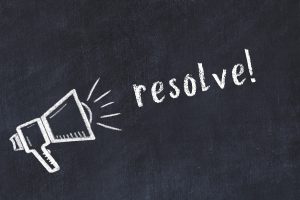Where have new year’s resolutions gone?
Here we are in peak resolution season and I haven’t heard the slightest murmur of one. Not one.
Sure we may have had bigger things to worry about this year. Like ushering 2020 out the door.
But I’m not sure that’s it.
New year’s resolutions have seemed to be dying a slow death for some time now and may have finally bitten the bullet.
From a serious business to a bit of fun to downright delusional
Probably at some point in time, new year’s resolutions lived up to their label. People would set their intentions for the coming year with a sense of determination. And then they would doggedly pursue and attain this goal throughout the course of the year.
But in more recent times, taking part in the whole new year’s resolution tradition seems to have shifted to be a bit of fun, like buying a lottery ticket. We’d playfully go through the motions on December 31 and find something to put on our wish list for the coming year.
It was nice to feel as though we’d given ourselves a chance at something we want, like the old chestnut of losing weight. But just like the lottery, we went into it knowing our chance of success was exceedingly slim.
So it came as no surprise when February had come around and the year had gotten serious that our new year’s resolution was forgotten and we got on with life. It was just some harmless holiday fun.
These days, new year’s resolutions have lost their charm. To set a new year’s resolution these days is kind of like you’re living under a rock and completely ignorant to the fact that they never work (as though you’ve been conned and bought yourself a faulty lemon).
So what changed?
The missing ingredient
Although most of us have probably come to subconsciously view resolutions with that kind of cynicism, when you actually stop to think about it, we can hardly blame the concept itself. It’s not that new year’s resolutions don’t work.
What has changed and tarnished the whole exercise is our behaviour. We’re not holding up the resolution part of our new year’s resolutions. We fail to enact its true meaning.
Which begs the question, what exactly does resolution mean?
We have a general idea of what it means but it’s one of those words that we use without really thinking about it. And in the case of “resolution”, it’s not even a word that gets used all that much. Like, rarely more than once a year.
So to save you the effort of grabbing your phone and looking it up, here’s a definition of resolution as it relates to this context along with a handful of synonyms:
Resolution1:
1. A firm decision to do or not do something.
Intention, decision, plan, proposal, proposition.
2. The quality of being determined or resolute.
Dedicated, purposeful, perseverant, bold, tenacious
Now honestly, how much resolution was in our resolution?
Can we really say that we made a resolution in the “firm decision” sense when we engaged in a bit of fanciful fun and made a wish for the new year?
And even if we did make this decision seriously, how resolute were we in our approach toward its accomplishment. How much determination, tenacity, perseverance, dedication and the like did we really display in the process of making that resolution a reality?
New year’s resolutions have inevitably become a flawed concept because they’ve come to comprise little or no resolution.
Lost in translation
I think a large part of the reason we’ve lost our way with new year’s resolutions comes from having lost connection with the word itself. After all, when was the last time you used the word “resolution”, “resolute” or “resolve”?
They’re old-fashioned terms that have fallen out of usage. And possibly both in conversation and behaviour because they’ve followed a similar curve – as use of the word resolution declined so too did the spirit and success of resolutions.
It makes complete sense. If we don’t use a word, we don’t fully appreciate or even consider its meaning (hence having to look it up just to be sure our assumption about what it means is correct when pressed to actually consider it). And when we unintentionally use a word or phrase, we probably won’t apply it in the same way that we would do a more meaningful one.
We’re not speaking of resolution and consequently, we’re not displaying it. When it came time to sign up for a new year’s resolution, we came to see it as a bit of a holiday game and then a whole lot of cringe.
We have lost our way with resolutions in their true definition because we genuinely don’t consider what it actually means.
Resurrecting resolution
It’s clear wee need to gain greater resolution. Not for the simple purpose of being more successful in the new year’s department. But for doing better at life in general.
Resolution is at the heart of everything we do – even if the word isn’t. It underpins the decisions and behaviours that are the foundation of building a healthy lifestyle and body.
So here’s a couple of tips to cultivate this valuable commodity.
And I mean all year round. A resolution needn’t be new year-related. When you think about it, maybe that’s another reason why we’re not so good at new year’s resolutions – we only attempt them once a year, if that.
Part 1. Making a resolution
This relates to the first part of our earlier definition – the decision. Specifically, is your decision firm or flaky?
Are you making a genuine and serious decision and plan? Or is it more wishful thinking?
If you aren’t certain and committed to your decision, then it’s really not a resolution.
In the case of a new year’s resolution, for example, if you’re not 100% certain on what you want on December 31 then don’t make a half-hearted “resolution”. Because you’ve already failed it by definition. And it won’t be long until you’ve also failed it in practice.
Just take a moment longer to firm things up. Make your resolution in February, May, anytime. Just figure out exactly what you want and what you’re prepared to commit yourself to.
Also take the plan aspect on board and consider how you’re going to make this resolution a reality. What’s that old saying, “A goal without a plan is just a wish”? So don’t make a firm decision and have it revert back into wish territory because you failed to plan. Which leads into another oldie, “Failing to plan is planning to fail.”
By taking this step more seriously, not only are we living up to the true meaning of resolution but we’re creating the right mindset to improve our chances at success. And mindset is critical to the next phase.
Part 2. Displaying resolution
This relates to the second part of our earlier definition – the qualities of resolution. Things like determination, dedication and perseverance.
Even a rock solid resolution can quickly come undone when amid the reality of the often long and challenging process of executing it. What may have begun firmly can quickly turn flaky.
That’s when we need to display resolution.
If we’re not resolute then we probably won’t continue putting in the time and effort that’s required, and our attempt with be short-lived.
So when we’re elbows deep in the grind of working towards our resolution (as in the firm decision), we need to focus on the quality of being resolute. This is the difference between quitting and adhering, failing and succeeding.
It’s a quality that we admire and respect greatly in others yet is within reach of us all.
And like anything, it just needs a little practice to grow.
So here’s a resolution for you
Let’s now draw a line in the sand and leave our past failed attempts with resolutions behind us. We’ll write them off as having been lost in translation.
We’re now armed with a clearer understanding of how we’ve been going wrong and what we can do about it.
So here’s a decent place to start – with resolution itself. Make the resolution to put resolution into practice. Make a firm decision about displaying more resolution.
If you really want to get into the spirit, you can even preach what you practice by throwing the word resolution into conversation here and there. It’ll be an easy way to chalk up a successful display of resolution because it shows you’re being purposeful.
What’s so great about setting a resolution that involves a quality like resolution (other than that it underpins just about everything) is that it’s a process not an outcome. And that means you can’t fail because there’s no objective benchmark or endpoint. It’s just a practice.
So go about this practice. And whenever you display a bit of resolution, bask in the sense of accomplishment at having fulfilled rather than failed your resolution.


